-
PDF
- Split View
-
Views
-
Cite
Cite
Nicholas Moellhoff, Chiara Kandelhardt, Denis Ehrl, Lukas Kohler, Konstantin Koban, Riccardo E Giunta, Anne Guertler, Samir Mardini, Sebastian Cotofana, Konstantin Frank, The Impact of Breast Symmetry on Eye Movement and Gaze Pattern: An Eye-Tracking Investigation, Aesthetic Surgery Journal, Volume 41, Issue 11, November 2021, Pages NP1512–NP1518, https://doi.org/10.1093/asj/sjab285
Close - Share Icon Share
Abstract
The objective assessment of beauty remains challenging despite ongoing research efforts. A new method of objectively determining the aesthetic appeal of body features by analyzing gaze patterns and eye movements has recently been investigated.
The objective of this study was to assess, by means of objective eye-tracking technology, differences in the gaze patterns of observers presented with standardized 3-dimensional images showing different degrees of breast asymmetry.
A total of 83 Caucasian study participants with a mean age of 38.60 (19.8) years were presented with 5 images depicting varying degrees of breast asymmetry. In addition to the assessment of eye movements, participants were asked to rate the aesthetic appeal and the asymmetry of the breasts on a 5-point Likert scale.
Overall, the data showed that participants’ rating of the breasts’ aesthetic appeal was inversely related to the level of asymmetry. The mean [standard deviation] time until fixation was shortest for the image depicting the greatest breast asymmetry (50 cc) at 0.77 [0.7] seconds (P < 0.001). In addition, the mammary region was also viewed longest in this image at 3.76 [0.5] seconds (P < 0.001). A volume difference of 35 cc between breasts deflected the observers’ gaze significantly toward the larger of the asymmetric breasts (P < 0.001).
Surgeons should focus on achieving symmetric breast volume (ie, differences <35 cc between breasts) to avoid noticeable asymmetry with regard to breast size.
Breast surgery is a main pillar of plastic surgery. According to statistics from The Aesthetic Society, 350,665 cosmetic and 224,230 reconstructive breast surgical procedures were performed in the United States in 2020.1 Profound knowledge of the ideal breast form and shape is vital for surgeons performing these operations and, therefore, ideals of breast beauty have been studied extensively. Breasts with an upper-pole/lower-pole ratio of 45:55, an upward-pointing nipple at an angle of 20°, a linear or mildly concave upper pole, and lower-pole convexity are rated as most aesthetically pleasing.2,3 In addition, breast symmetry adds to a female’s breast attractiveness and any form of asymmetry or breast size discrepancy can cause distress, social handicap, and a reduction in quality of life.4,5 The etiology of breast asymmetry is variable, including congenital, hormonal, or malignant causes.6-8 Breast surgery can ameliorate breast asymmetry and should aim at creating an ideal and well-balanced bilateral breast shape, thus re-establishing patients’ confidence, self-esteem, and quality of life. At the same time, however, breast asymmetry is also a complication after breast surgery, commonly reported after augmentation, reduction, or breast-conserving cancer surgery.9,10
The objective assessment of beauty remains challenging despite ongoing research efforts. A new means of objectively determining the aesthetic appeal of body features by analyzing gaze patterns and eye movements has recently been investigated. Previous investigations of various anatomic facial regions by means of innovative eye-tracking technology revealed that an observer’s gaze is attracted faster, and visual fixation prevails for longer, when presented with unharmonious features.11 Based on these findings, the tracking of eye movements could also prove useful to assess the beauty of the breast, to objectively evaluate the extent of asymmetry necessary to cause a measurable deflection of an observer’s perception, and to evaluate surgical outcome.
The objective of this study was to assess, by means of objective eye-tracking technology, differences in the gaze patterns of observers presented with standardized 3-dimensional (3D) images showing different degrees of breast asymmetry. The aim was to track eye movements and to correlate findings with subjective assessment of the aesthetics and asymmetry of the breasts.
METHODS
Study Sample
A total of 83 Caucasian study participants with a mean [standard deviation] age of 38.60 [19.8] years (range, 18-83 years), of whom 38 (45.8%) were males and 45 (54.2%) were females, were included in the study, which was performed between January 2021 and March 2021. The study participants were investigated at the Mayo Clinic College of Medicine and Science, Rochester, MN. All participants were laypersons and had no background in plastic, aesthetic, or reconstructive surgery. Exclusion criteria were severe vision impairment which would not allow the participant to assess the presented images, or lack of binocular vision (for example, due to loss of an eye). Prior to participation, subjects were informed about the broad aim and the scope of this study. Written consent was provided by which the subjects agreed to the use and analysis of their data. The study was approved by the Mayo Clinic College of Medicine and Science IRB (protocol number 20-1018).
Eye-Movement Analysis
A Tobii Pro Nano binocular eye-tracker (Tobii Pro AB, Stockholm, Sweden) was utilized to capture eye movements of the 83 volunteers as described in previous protocols.11,12 In brief, the eye-tracking device operated at a frequency of 60 Hz and was positioned at the inferior border of the monitor of a laptop (Surface Laptop 3, Microsoft, Redmond, WA). The laptop’s 15-inch monitor had a screen size of 340 mm × 244 mm. Eye movement was recorded at a distance of up to 65 cm to the eye tracker and at lateral and cranial distances of 35 and 30 cm, respectively.
Visual Stimulus Presented
Participants were presented with 5 different visual stimuli. 3D images portrayed the same female torso in frontal view with different degrees of breast asymmetry. To create the images, a whole-body scan of a female was performed with a VECTRA WB360 3D imaging system (Canfield Scientific Inc., Fairfield, NJ). The baseline image was edited with the Mirror Software Suite (Canfield Scientific) to show perfect breast symmetry in terms of breast volume, sternal notch to nipple distance, base width, nipple to inframammary fold distance, breast height, and angle of nipple projection.
Starting from the baseline image, different levels of asymmetry were simulated by incrementally increasing the volume of the right breast by 15, 20, 35, and 50 cc. The images were displayed in a randomized order for a duration of 8 seconds each, with a plain black screen displayed between consecutive images for a duration of 3 seconds each.
Data Analysis
Eye Tracking
Gaze pattern was recorded and analyzed with the proprietary software kit (Figures 1-3). The following variables were assessed:
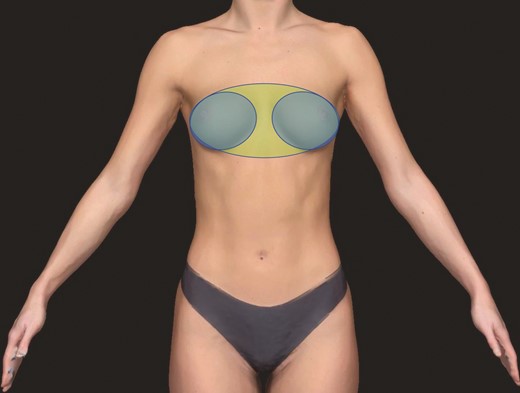
The areas of interest investigated to assess time until first fixation and total time of fixation. The bilateral breasts of a 26-year-old female were assessed individually (blue shape) and the entire mammary region was assessed jointly (green shape).
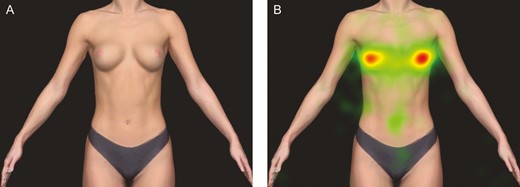
(A) The visual stimulus (26-year-old female, also featured in Figure 1) and (B) the respective averaged eye-tracking heat map of all observers depicting the duration of gaze on the respective area for perfectly symmetric breasts. The red areas in (B) indicate a long duration of stable eye fixation during the 6-second image exposure interval.
Time until first fixation of the mammary region and/or each breast, defined as the interval between initial display of the image and a stable eye fixation of the breast (minimum threshold, 0.1 seconds).
Time of fixation of the mammary region and/or each breast, defined as the duration of a stable eye fixation on the breast within the 8 seconds of image exposure time.
Aesthetic and Asymmetry Rating
After recording the gaze, images were again presented in a randomized order to the subjects. Individuals rated the aesthetic appeal and symmetry of the displayed images on a 5-point Likert scale: (1) very unattractive, (2) unattractive, (3) neutral, (4) attractive, (5) very attractive, and (1) very symmetric, (2) symmetric, (3) neutral (4) asymmetric, (5) very asymmetric.
Statistical Analysis
Data were tested for normal distribution by the Kolmogorov-Smirnov test (P > 0.05). Differences in time until first fixation and total time of fixation between the right and the left breast were assessed by unpaired Student’s t test. A Pearson bivariate correlation between Likert scale ratings and gaze pattern values was performed. All calculations were conducted with SPSS Statistics 27 (IBM, Armonk, NY) and results were considered statistically significant at a probability level of ≤0.05 to guide conclusions.
RESULTS
Aesthetic and Asymmetry Rating
Participants rated the aesthetic appeal of perfectly symmetric breasts (baseline image) highest with a mean score of 4.22 [0.81] (range, 2-5) on the 5-point Likert scale. Asymmetry was rated highest for a volume difference of 50 cc between left and right breasts with a score of 4.05 [0.79] (range, 1-5) on the 5-point Likert scale (Table 1; Figure 4). Pearson’s correlation revealed a significant reciprocal relation between aesthetic appeal and asymmetry rating of the mammary region (r = –0.574 and P < 0.001). No gender differences could be observed for aesthetic appeal and asymmetry rating (P ≥ 0.469).
Mean Aesthetic Rating and Asymmetry Rating, Time Until Fixation, and Total Time of Fixation
| Breast asymmetry (cc) . | Aesthetic rating . | Asymmetry rating . | Time until fixation (seconds) . | P value . | Total time of fixation (seconds) . | P value . |
|---|---|---|---|---|---|---|
| 0 | 4.22 [0.8] | 1.47 [0.5] | 1.34 [0.61] | – | 3.10 [0.52] | – |
| 15 | 4.12 [0.6] | 1.97 [0.7] | 1.24 [0.65] | 0.911 | 3.16 [0.50] | 0.945 |
| 20 | 3.81 [0.7] | 2.30 [0.7] | 1.17 [0.71] | 0.561 | 3.21 [0.49] | 0.649 |
| 35 | 3.04 [0.8] | 3.27 [0.6] | 0.83 [0.70] | <0.001 | 3.671 [0.48] | <0.001 |
| 50 | 2.53 [0.7] | 4.05 [0.8] | 0.77 [0.75] | <0.001 | 3.667 [0.46] | <0.001 |
| Breast asymmetry (cc) . | Aesthetic rating . | Asymmetry rating . | Time until fixation (seconds) . | P value . | Total time of fixation (seconds) . | P value . |
|---|---|---|---|---|---|---|
| 0 | 4.22 [0.8] | 1.47 [0.5] | 1.34 [0.61] | – | 3.10 [0.52] | – |
| 15 | 4.12 [0.6] | 1.97 [0.7] | 1.24 [0.65] | 0.911 | 3.16 [0.50] | 0.945 |
| 20 | 3.81 [0.7] | 2.30 [0.7] | 1.17 [0.71] | 0.561 | 3.21 [0.49] | 0.649 |
| 35 | 3.04 [0.8] | 3.27 [0.6] | 0.83 [0.70] | <0.001 | 3.671 [0.48] | <0.001 |
| 50 | 2.53 [0.7] | 4.05 [0.8] | 0.77 [0.75] | <0.001 | 3.667 [0.46] | <0.001 |
Values are mean [standard deviation]. The P value indicates the significance of the value relative to the baseline (0 cc) image.
Mean Aesthetic Rating and Asymmetry Rating, Time Until Fixation, and Total Time of Fixation
| Breast asymmetry (cc) . | Aesthetic rating . | Asymmetry rating . | Time until fixation (seconds) . | P value . | Total time of fixation (seconds) . | P value . |
|---|---|---|---|---|---|---|
| 0 | 4.22 [0.8] | 1.47 [0.5] | 1.34 [0.61] | – | 3.10 [0.52] | – |
| 15 | 4.12 [0.6] | 1.97 [0.7] | 1.24 [0.65] | 0.911 | 3.16 [0.50] | 0.945 |
| 20 | 3.81 [0.7] | 2.30 [0.7] | 1.17 [0.71] | 0.561 | 3.21 [0.49] | 0.649 |
| 35 | 3.04 [0.8] | 3.27 [0.6] | 0.83 [0.70] | <0.001 | 3.671 [0.48] | <0.001 |
| 50 | 2.53 [0.7] | 4.05 [0.8] | 0.77 [0.75] | <0.001 | 3.667 [0.46] | <0.001 |
| Breast asymmetry (cc) . | Aesthetic rating . | Asymmetry rating . | Time until fixation (seconds) . | P value . | Total time of fixation (seconds) . | P value . |
|---|---|---|---|---|---|---|
| 0 | 4.22 [0.8] | 1.47 [0.5] | 1.34 [0.61] | – | 3.10 [0.52] | – |
| 15 | 4.12 [0.6] | 1.97 [0.7] | 1.24 [0.65] | 0.911 | 3.16 [0.50] | 0.945 |
| 20 | 3.81 [0.7] | 2.30 [0.7] | 1.17 [0.71] | 0.561 | 3.21 [0.49] | 0.649 |
| 35 | 3.04 [0.8] | 3.27 [0.6] | 0.83 [0.70] | <0.001 | 3.671 [0.48] | <0.001 |
| 50 | 2.53 [0.7] | 4.05 [0.8] | 0.77 [0.75] | <0.001 | 3.667 [0.46] | <0.001 |
Values are mean [standard deviation]. The P value indicates the significance of the value relative to the baseline (0 cc) image.
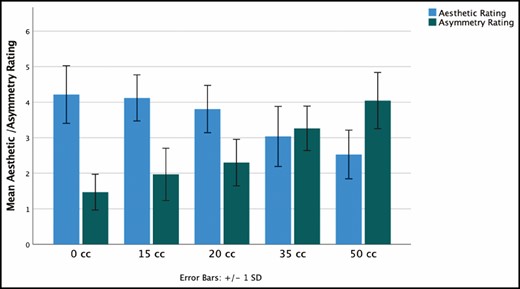
Bar graph showing the mean aesthetic and asymmetry ratings for the respective asymmetries.
Time Until First Fixation
In the image depicting perfectly symmetric breasts (baseline image), the mean time until fixation on the mammary region was 1.34 [0.61] seconds (range, 0.57-4.50 seconds). No statistically significant difference in the time until first fixation was observed between baseline and the images depicting 15- and 20-cc volume differences between the left and right breasts (P > 0.562) (Table 1; Figure 5). A volume difference of 35 cc revealed a statistically significant (P < 0.001) difference in time until first fixation compared with baseline of 0.83 [0.70] seconds (range, 0.1-5.4 seconds). A 50-cc volume difference revealed a similar statistically significant (P < 0.001) difference of 0.77 [0.75] seconds (range, 0.2-5.1 seconds). Pearson’s correlation revealed a significant positive relation between aesthetic appeal and time until first fixation on the mammary region (r = 0.226 and P < 0.001). Pearson’s correlation revealed a significant negative relation between asymmetry rating and time until first fixation on the mammary region (r = –0.264 and P < 0.001).
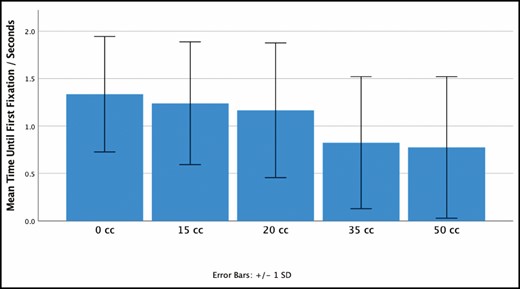
Bar graph showing the mean time until first fixation in seconds for the respective asymmetries.
When looking at time until first fixation on the left and the right breast individually, no statistically significant difference was found for perfectly symmetric breasts and breasts with an asymmetry of 15 and 20 cc (P > 0.073) (Table 2). Statistically significant differences of time until first fixation between the left and right breasts were found for breasts with asymmetries of 35 and 50 cc (P ≤ 0.001). No gender differences were detected when investigating the time until first fixation for all simulated asymmetries (P ≥ 0.651).
| Breast asymmetry (cc) . | Time until fixation (seconds) . | . | . | Total time of fixation (seconds) . | . | . |
|---|---|---|---|---|---|---|
| . | Right . | Left . | P value . | Right . | Left . | P value . |
| 0 | 1.38 (0.67) | 1.33 (0.88) | 0.696 | 3.17 (0.69) | 3.10 (0.69) | 0.527 |
| 15 | 1.34 (0.88) | 1.25 (0.96) | 0.527 | 3.13 (0.64) | 3.12 (0.67) | 0.922 |
| 20 | 1.46 (1.08) | 1.17 (0.97) | 0.073 | 3.09 (0.54) | 3.24 (0.73) | 0.159 |
| 35 | 1.35 (0.55) | 0.85 (0.94) | <0.001 | 3.15 (0.67) | 3.69 (0.69) | <0.001 |
| 50 | 1.31 (0.84) | 0.79 (1.11) | 0.001 | 3.20 (0.63) | 3.67 (0.68) | <0.001 |
| Breast asymmetry (cc) . | Time until fixation (seconds) . | . | . | Total time of fixation (seconds) . | . | . |
|---|---|---|---|---|---|---|
| . | Right . | Left . | P value . | Right . | Left . | P value . |
| 0 | 1.38 (0.67) | 1.33 (0.88) | 0.696 | 3.17 (0.69) | 3.10 (0.69) | 0.527 |
| 15 | 1.34 (0.88) | 1.25 (0.96) | 0.527 | 3.13 (0.64) | 3.12 (0.67) | 0.922 |
| 20 | 1.46 (1.08) | 1.17 (0.97) | 0.073 | 3.09 (0.54) | 3.24 (0.73) | 0.159 |
| 35 | 1.35 (0.55) | 0.85 (0.94) | <0.001 | 3.15 (0.67) | 3.69 (0.69) | <0.001 |
| 50 | 1.31 (0.84) | 0.79 (1.11) | 0.001 | 3.20 (0.63) | 3.67 (0.68) | <0.001 |
Values are mean [standard deviation]. The P value indicates the significance of the difference between the right and left breasts.
| Breast asymmetry (cc) . | Time until fixation (seconds) . | . | . | Total time of fixation (seconds) . | . | . |
|---|---|---|---|---|---|---|
| . | Right . | Left . | P value . | Right . | Left . | P value . |
| 0 | 1.38 (0.67) | 1.33 (0.88) | 0.696 | 3.17 (0.69) | 3.10 (0.69) | 0.527 |
| 15 | 1.34 (0.88) | 1.25 (0.96) | 0.527 | 3.13 (0.64) | 3.12 (0.67) | 0.922 |
| 20 | 1.46 (1.08) | 1.17 (0.97) | 0.073 | 3.09 (0.54) | 3.24 (0.73) | 0.159 |
| 35 | 1.35 (0.55) | 0.85 (0.94) | <0.001 | 3.15 (0.67) | 3.69 (0.69) | <0.001 |
| 50 | 1.31 (0.84) | 0.79 (1.11) | 0.001 | 3.20 (0.63) | 3.67 (0.68) | <0.001 |
| Breast asymmetry (cc) . | Time until fixation (seconds) . | . | . | Total time of fixation (seconds) . | . | . |
|---|---|---|---|---|---|---|
| . | Right . | Left . | P value . | Right . | Left . | P value . |
| 0 | 1.38 (0.67) | 1.33 (0.88) | 0.696 | 3.17 (0.69) | 3.10 (0.69) | 0.527 |
| 15 | 1.34 (0.88) | 1.25 (0.96) | 0.527 | 3.13 (0.64) | 3.12 (0.67) | 0.922 |
| 20 | 1.46 (1.08) | 1.17 (0.97) | 0.073 | 3.09 (0.54) | 3.24 (0.73) | 0.159 |
| 35 | 1.35 (0.55) | 0.85 (0.94) | <0.001 | 3.15 (0.67) | 3.69 (0.69) | <0.001 |
| 50 | 1.31 (0.84) | 0.79 (1.11) | 0.001 | 3.20 (0.63) | 3.67 (0.68) | <0.001 |
Values are mean [standard deviation]. The P value indicates the significance of the difference between the right and left breasts.
Total Time of Fixation
In the image depicting perfectly symmetric breasts (baseline image), the mean total time of fixation on the mammary region was 3.10 [0.52] seconds (range, 2.12-5.20 seconds). When comparing baseline to the individual consecutive images depicting breast asymmetry, no statistically significant difference (P ≥ 0.649) was found for the 15- and 20-cc asymmetries, whereas a significant difference was found for the greater asymmetries (Table 1; Figure 6). Pearson’s correlation revealed a significant negative relation between aesthetic appeal and total time of fixation on the mammary region (r = –0.286 and P < 0.001). Pearson’s correlation revealed a significant positive relation between asymmetry rating and total time of fixation on the mammary region (r = 0.399 and P < 0.001).
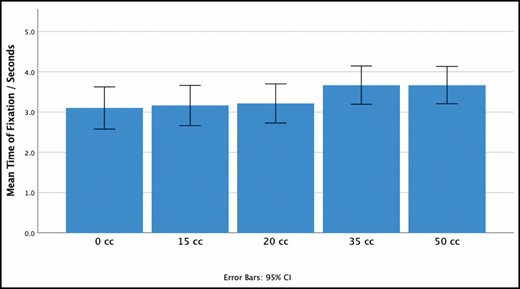
Bar graph showing the overall time of fixation in seconds for the respective asymmetries.
When comparing total time of fixation between left and right breasts, no statistically significant difference was found up to a volume difference of 20 cc (P ≥ 0.159) (Table 2). A volume difference between left and right breasts of 35 and 50 cc revealed a significantly (P < 0.01) longer time of total fixation on the left breast of 3.69 [0.69] seconds (range, 2.56-5.83 seconds) vs 3.15 [0.67] seconds (range, 2.15-5.31 seconds) and 3.67 [0.68] seconds (rang, 2.62-5.72 seconds) vs 3.20 [0.63] seconds (range, 2.19-4.40 seconds), respectively. (Table 2) No gender differences were detected when investigating the total time of fixation for all simulated asymmetries (P ≥ 0.052).
Discussion
It is commonly expressed that beauty, including breast attractiveness, lies in the eye of the beholder, which makes reliable, standardized, and objective assessment challenging. To date, there is no universal scale for the evaluation of breast aesthetics. This has specific implications for plastic surgeons because a discrepancy in the perception of beauty can be problematic especially with regard to postoperative outcomes.13 Eye-tracking technology allows for the objective analysis of gaze, based on the analysis of eye movements, which can be used to quantify the emotional response to visual stimuli. To date, only a handful of studies have explored the potential of eye-tracking technology in providing an objective tool to assess the perception of breast aesthetics.14-17
This study analyzed the gaze pattern of observers presented with 3D images of a female torso with 4 different levels of breast asymmetry and compared outcomes with subjective ratings of aesthetic appeal and asymmetry. The eye movements of a total of 83 participants were recorded and analyzed regarding time until first fixation and total time of fixation on the mammary region in general, as well as on the individual breasts. Overall, the data show that participants rating of the breasts’ aesthetic appeal was inversely related to the level of asymmetry. Time until fixation was shortest for the image depicting the greatest breast asymmetry, with a volume difference of 50 cc between right and left breast. Previously, we reported that an observer’s gaze is attracted faster, and visual fixation prevails for longer, when presented with unharmonious features.11 Importantly, the data of this study revealed a decrease in the time until first fixation on the mammary region with increasing asymmetry, thus underlining the aforementioned findings. In addition, there was a significant positive correlation between asymmetry ratings and the total time of fixation on the chest. Interestingly, when analyzing breasts separately, a volume difference of 35 cc was the threshold value at which an observer´s eye movement was deflected measurably—away from homogeneous screening of the entire mammary region and toward a more focused visual fixation on the larger breast.
Potentially, one could therefore conclude that the maximum volume difference between breasts that goes unnoticed by uninformed viewers lies between 20 and 35 cc. Thus, a volume difference of 20 to 35 cc could be a clinical cut-off value for relevant asymmetry in preoperative evaluation and postoperative assessment. Liu et al evaluated preoperative asymmetry in 100 breast augmentations prior to operation and found that a vast majority of patients presented with some degree of (unnoticed) asymmetry.18 They defined significant breast volume asymmetry as a difference greater than 20 mL between left and right breasts. The data presented in our manuscript support this definition.
An eye-tracking investigation conducted by Pietruski et al revealed that lower regions of the breasts, as well as the nipple-areola complex (NAC), were the center of attention when viewing a female torso, irrespective of the observer’s gender. Cai et al highlighted the importance of a reconstructed NAC in female breast reconstructions to divert the viewer’s attention from surgical scars. Dixson et al set out to determine men’s preferences for female breast size, and their gaze-pattern analysis revealed that variations in breast size had no significant impact on eye-movement measures.15 Our study adds to these data, demonstrating that asymmetric breasts deflect the observer’s attention toward the larger breast. In 2010, Leder et al reported that when looking at 2 people standing next to each other, subjects tend to look longer at the person they rate as more attractive.19 Because the observers’ eye movements hovered over the larger breast in asymmetric images, one could hypothesize that the larger breast might have been rated as more attractive, whereas the smaller breast was regarded as hypoplastic. Unfortunately, breasts were not rated separately regarding aesthetic appeal in this study design, which would have strengthened this hypothesis. Although some studies have demonstrated that medium or large, rather than small breasts, are rated most attractive, there is ongoing debate and studies are often subject to bias by cultural background, age, gender, and societal influences of participants, which is why results must be regarded critically.15,20,21
To the best of our knowledge, no classification system of the degree of breast asymmetry exists based on the extent of volume disparity between breasts. The combination of eye-tracking technology and 3D volumetric analysis could in the future provide a useful tool for defining different levels of breast asymmetry according to a new scaling system. These studies should include a larger sample cohort (with multiple baseline breast sizes), present images at different viewing angles (frontal, 45° oblique, lateral) and investigate volume differences in steps of 5 cc to acquire more accurate data. In addition, studies should include analysis of asymmetric inferior mammary fold level, breast width, breast projection, or NAC position. A future scaling system could then incorporate these parameters to acquire a holistic classification of asymmetry, based on eye-tracking technology and 3D measurements; previous studies have already laid the technical groundwork by performing breast asymmetry analysis with these medical devices.22-24
The large sample size of this investigation is a main strength of the study. In addition, the testing environment was standardized and constant for all participants. In order to reduce any distraction of gaze and to ensure participant’s focus on the images depicted on the screen, all analyses were performed in the same room, a noise-free environment, and under constant (daylight) lighting conditions. Prior to presentation of the visual stimulus, calibration of the eye-tracking device was performed for each participant, to ensure accuracy of measurements. Breast volume changes were computed with the software of an established and approved medical device, thus ensuring the validity of the presented volume changes.
Despite its strengths, this study is not free of limitations. Foremost, this study only analyzed changes in gaze patterns when presenting images with different breast volumes. However, volume is merely one of many factors contributing to breast asymmetry. As stated previously, an asymmetric inferior mammary fold, differences in breast width and projection, as well as positioning of the nipple contribute to a symmetric décolleté. Moreover, images were portrayed in frontal view only, and presented the same Caucasian female in all images.
In 1976, Porac et al established that visual input from one eye is preferred over the other.25 This phenomenon, known as ocular dominance, could have influenced the viewing pattern, thereby having an impact on the findings of this study. As subjects’ ocular dominance was not assessed prior to the investigation, it was decided to only vary the right breast in size. To further consolidate the current findings, in future studies variable breast sizes should be presented irrespective of the side of the breast. Future studies will also need to assess the gaze of observers when looking at different torsos at different angles. Another limitation of this investigation is the limited ethnic diversity of the observers. Previous studies revealed significant differences regarding preferences for upper-pole fullness, areola size in the natural breast, and areola size in the augmented breast across plastic surgeons from different countries.26 Future studies should focus on the interplay between ethnic background, aesthetic preference, and eye movement when observing breast asymmetry.
Conclusions
This study assessed the impact of breast asymmetry on gaze patterns by means of objective eye-tracking technology. Eye movements were tracked and correlated to subjective aesthetic assessment and breast asymmetry ratings. Increasing asymmetry caused a decrease in the time until fixation and an increase in the total time of fixation. A volume difference of 35 cc deflected the observers’ attention significantly toward the larger of the asymmetric breasts. Surgeons should focus on achieving symmetric breast volume (ie, differences <35 cc between breasts) to avoid noticeable asymmetry with regard to breast size.
Disclosures
The authors declared no potential conflicts of interest with respect to the research, authorship, and publication of this article.
Funding
The authors received no financial support for the research, authorship, and publication of this article.
References




